BHAP Hosts Archaeological Field School! A Report from Dr. Hugh McKenzie.
August 22, 2013
Link to full report with great photos HERE.
Between July 18-August 22nd, 2013, the Baikal-Hokkaido Archaeology Projected hosted an undergraduate archaeological field school. This course, offered through MacEwan University by BHAP member Hugh McKenzie gave 15 students the opportunity to gain both academic credit and hands-on experience, as well as to experience Japan. We would like to thank everyone who helped make this course a success, especially our Japanese colleagues who worked so hard to ensure that our students had a safe, rewarding, and exciting trip (Thank you Kato-sensei, Sachiko-san, Yumi-san, Mayumi-san, and everyone else at the site). Thank you also to the funding from SSHRC, the Core-to-Core Program, and the Campus Alberta Grant for International Learning.

Archaeological Skills Obtained
Hamanaka II is an extraordinary archaeological site for students to learn field methods. It consists of a multilayered residential shell midden that provides a record of continuous occupation from approximately 3000 BC - present. As such, the site provides a unique opportunity for students to observe change through time and to encounter a diverse range of archaeological materials (e.g., shell remains, animal bones, human burials, ritual deposits, pottery, stone tools, metal objects, etc.). This season, we were particularly fortunate to find a number of unusual items, including two human burials, several dog burials, and some ritual sea lion deposits. Archaeological field schools with the potential to excavate such a diverse range of materials are extremely rare, particularly for students in North American institutions. This, in itself, made the field school a valuable opportunity for Alberta students.
ANTH 396: Archaeological Field Methods was designed to build student competencies in all practical aspects of archaeological field techniques, including surveying, excavation, documentation, photography, conservation and analysis.
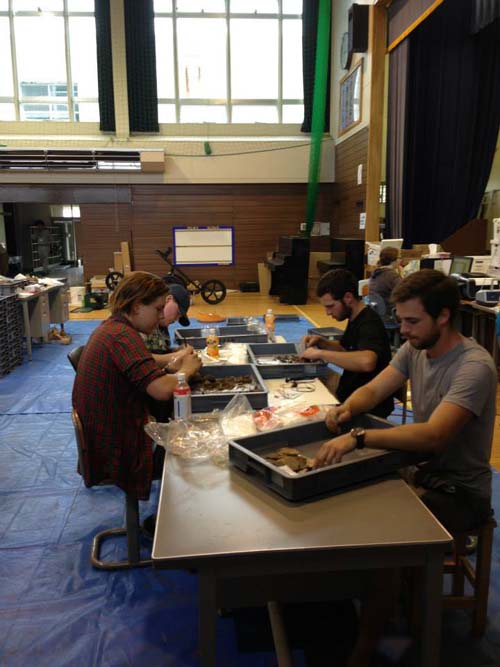
To this end, students were required to complete a number of tasks: excavating; cleaning and analyzing artifacts in the field laboratory; archaeological survey working the laser Total Station; and collaborating on their notes to document their work at the excavation.
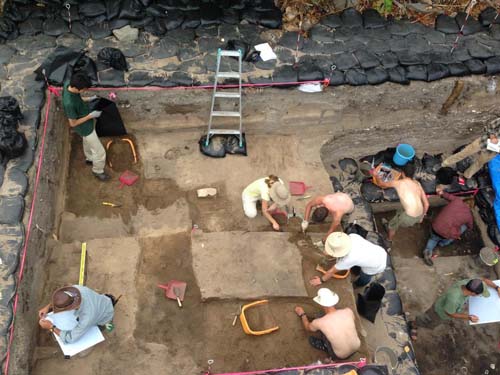
Edmonton and Sapporo Orientations
Prior to conducing archaeological fieldwork, students were required to participate in two short but intensive orientation to the prehistory and history of Hokkaido, geography, flora and fauna, mapping, orienteering, field recording systems, and artifact analysis.
The first orientation was in Edmonton, and also included an introduction to the local cultural values, practices, and institutions as well as a presentation on precautionary, risk reducing practices to follow while overseas.
Then, upon arriving in Japan, the students spent another two days in Sapporo receiving further orientation through lectures from our Japanese colleagues (thank you!) as well as visits to local museums to become familiar with the kinds of materials they would be encountering at our excavation. These pre-departure activities ensured that all students had sufficient background to be successful in the field.
International, Interpersonal, Intercultural Experiences!
This summer, our students experienced life in a small, rural, Japanese fishing village, and were able to participate in a number of unique cultural events, both formal and informal. Many of these cultural activities were organized and hosted by the Board of Education on Rebun Island, and we are grateful for their support and partnership.
At the beginning of our field season, students participated in a purifying ceremony conducted by elders from the Ainu Association of Hokkaido.
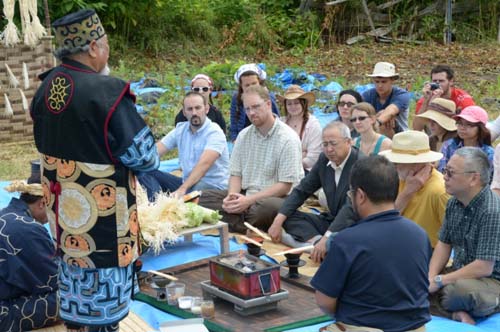
They were provided behind the scenes tours of a several museums, learned how to write traditional Japanese Calligraphy, were given a Taiko drumming concert and then provided with lessons on how to play them, and learned how to play numerous traditional Japanese games and fold origami.
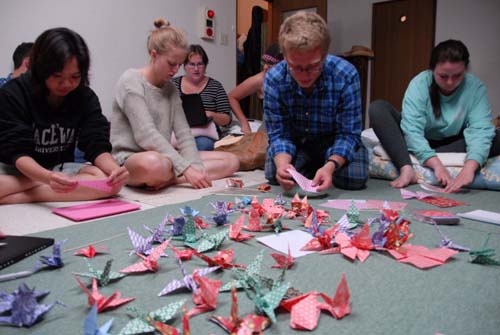
Students also went to the "Uni Shelling Experience", where they learned to shuck sea urchin, which is a local delicacy and important export item for Rebun Islanders.
In addition to the formal cultural program organized by the Rebun Island Board of Education, our students also interacted with local villagers on a daily basis and made numerous friendships. We attended a local street festival and on several occasions we were invited to the homes of local people for meals and talk.
Partnerships, Old and New
This course was only possible because of a number of important partnerships. First, the excavation was hosted by the Baikal Hokkaido Archaeology Project (BHAP), which is an international and multidisciplinary research project investigating prehistoric hunter-gatherer lifeways across northeast Asia (http://bhap.arts.ualberta.ca/). In addition to providing logistical support, BHAP also contributed financially to the field school by subsidizing some student expenses (BHAP has its headquarters at the University of Alberta).
More than this, however, numerous BHAP scholars are leaders in their field, and we were fortunate that many of them came to the field this summer, where they were extremely generous with their time and expertise. They dug beside students, gave guest lectures and hands-on workshops. It is especially worth of note that several of our senior undergraduate students (some who will now graduate) took advantage of these opportunities to have discussions with these leading scholars about potential graduate school opportunities. I would not at all be surprised to see some of our students from this year go on to graduate school in archaeology across North America.
Special thanks to all of the BHAP Advisory Board members who helped: Junko Habu, Ben Fitzhugh and David Yesner, and former BAP graduate student, Cameron Robertson, of Golder Associates, who gave a guest lecture on careers in archaeology.
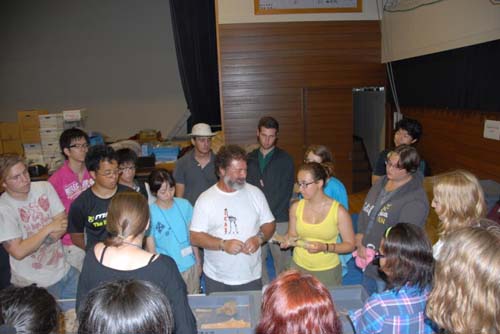
Second, this course also benefitted from partnership with the Japanese Core-to-Core Foundation, which provided funding for Western Scholars to travel to Japan. This partnership also allowed numerous Japanese specialists (also world leaders) to come to the field to deliver lectures and workshops.
Third, we are fortunate to have strong relations with the Ainu Association on Hokkaido. Ainu elders came to the site to bless our excavations, and our students were able to participate in these ceremonies.
Fourth, all of the various communities on Rebun Island were extremely welcoming to our team. The local Board of Education organized a formal "Cultural Program" for the students (described above), which allowed students to have a taste of Japanese Culture, as well as allowed us to meet many local people. In return, our excavation hosted several Public Archaeology Days, in which local school children and members of the public could come and work beside our students in the excavation. This not only provided local islanders with a better understanding of why we were there, digging in their backyards, but it also provided our students with yet another opportunity to engage with local Japanese people. We are currently initiating an effort to help translate many of the exhibits in their impressive local museum to make it more accessible to non-Japanese tourists.
Public Archaeology Day with a local high school.

Similarly, we also hosted an English Language Course Practicum for students from Hokkaido University. Students from HU came to the site for one week, where they lived in the same town as our students and worked beside them on the excavation, as a means to practice their English. This year was a trial run, but our Japanese colleagues were so pleased with the results, they intend to expand the program next time so that the Japanese students can stay for the entire duration of the excavation.
Finally, it is worth noting, that a television crew from Sapporo spent an entire week at our excavation filming our work together. The program is expected to air this fall.
